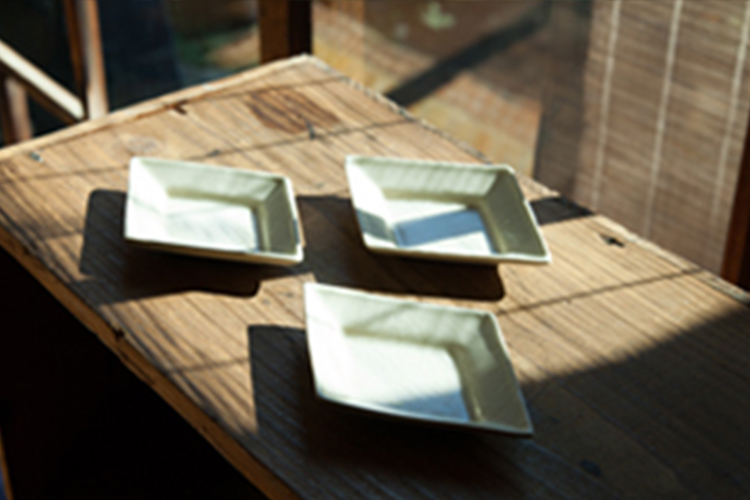Natsutsubaki and Warm Table Settings for Winter Gatherings
Dec 12,2013
Natsutsubaki and Warm Table Settings for Winter Gatherings
Dec 12,2013
Wherever you go in Japan, you’ll find pieces of tableware with a character all their own. They reflect the country’s cultural diversity and the vision of the artists who made them. Their presence adds sparkle to everyday surroundings. In this series, the owner of a tableware gallery showcases tableware that brightens your day and lends color to the season.
For this installment we visited Eto Aya, proprietor of the gallery Natsutsubaki, and asked her to show us table settings for a cold winter’s day. She selected several items perfect for enjoying a hot meal with close friends in winter when the sun sets early.
“I’ve combined deep, rich colors without being overelaborate, envisioning a cozy gathering around a hot meal on a relaxed winter day. The first thing that came to mind to add warmth to the dining table was this heat-resistant dish with its beautiful amber glaze. I’ve used it here for gratin, but it could equally well be used for quiche or apple pie. The great thing about heat-resistant crockery is the way it keeps things warm. Stainless steel is better for heating food quickly, but this type of dish is perfect for preventing food from losing heat and keeping it warm. It lets you serve food to guests piping hot from the oven. All you have to do is put it on the table, and it’s picture-perfect. What’s not to like about it?”
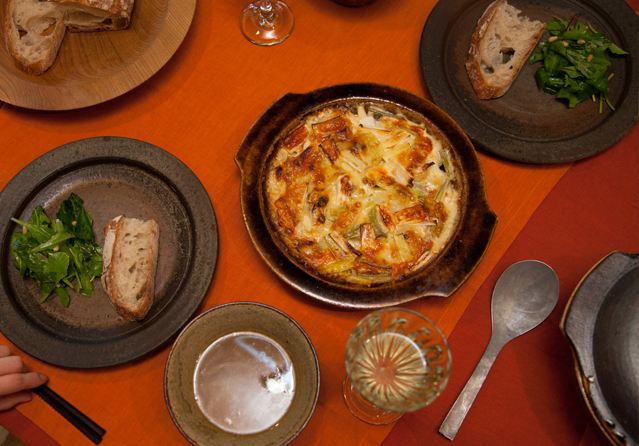
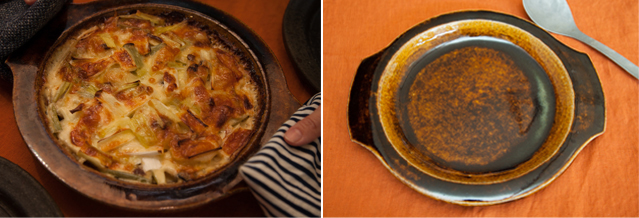
This heat-resistant dish is the work of Yamamoto Noriyuki of the Iwai Kiln in Tottori. It looks striking with its deep hue and distinctive, sturdy appearance. Noriyuki also made the multipurpose earthenware casserole and the gray dishes with their ash glaze.
“When I select tableware to use for years to come, I look for things that are as free of daintiness as possible. Plain they certainly are, but dishes like this exude warmth and good taste in their design, colors, and earthy texture while eliminating every trace of daintiness. I don’t think you’ll ever grow tired of using them.”
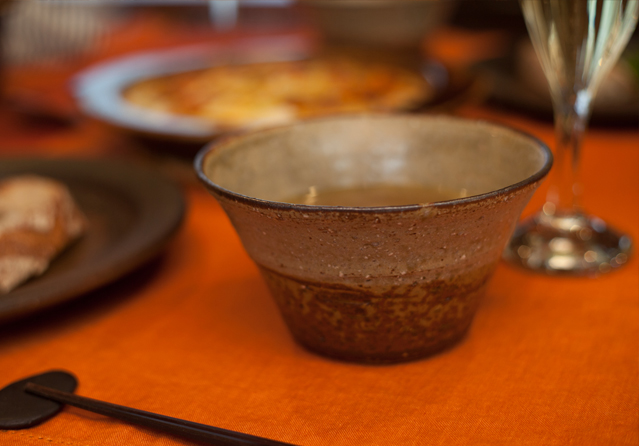

“The milk warmer is also by Yamamoto-san. It’s designed for warming milk, but I use it to warm other beverages as well. I add coffee to make café au lait, for example. This vessel retains heat well. Once you’ve heated a drink in it, it stays warm for quite a while. I’m very fond of it.”
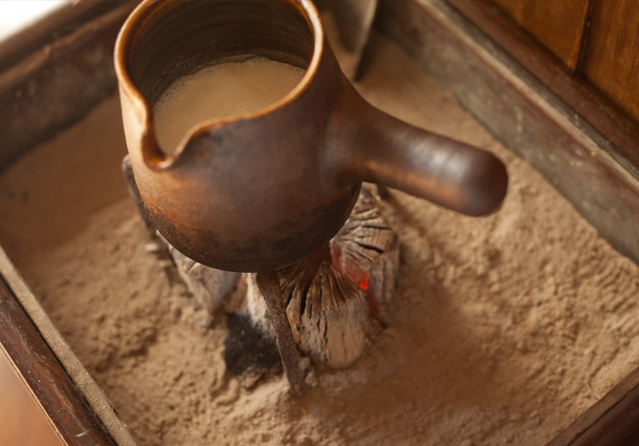

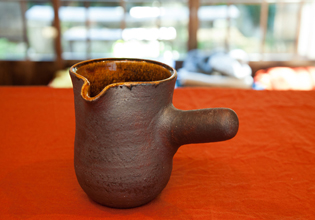
Another type of tableware that Aya strongly recommends for a cold winter’s day is yakishime or unglazed stoneware.
“Things like white porcelains tend to get all the attention because they’re easy to use, but unglazed stoneware with its plump, rounded contours also has its charms. It has a powerful aura that highlights the food and makes the meal picture-perfect — even an unelaborate meal like this consisting of just green salad with bread and gratin. There’s tableware that plays up the food by fading into the background, and then there’s tableware with an aura worth enjoying in its own right. That aura may take various forms. Crockery of unusual colors or designs doesn’t go well with everything, but it can be enjoyed in its own unique way. This unglazed stoneware, on the other hand, presents no such difficulties despite its distinctive aura. Its hefty appearance highlights the food. Some people may wonder whether something as solid-looking as stoneware or slipware is really going to match their dining table. But when a table setting is bit too light and airy because the tableware is white, adding a single such dish will create quite an impact, yet it will still blend in with the other dishes. You should definitely give it a try.” Aya urges.
“This stoneware is by Ichikawa Takashi. Besides this stoneware series, he also makes a series of white ceramics known as shirashi. What sets his pieces apart are their convenience and suitability for daily use. After all, he cooks himself.”
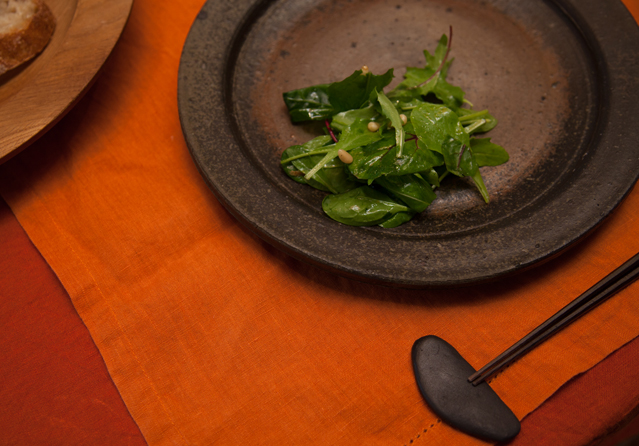


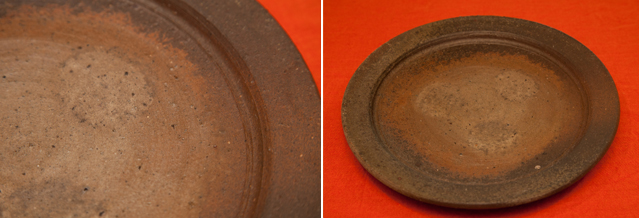
“The wooden plate with the bread on it is the work of Suda Jiro. People think maybe they shouldn’t use wooden dishes for anything wet or juicy. They’re worried they might stain. But this plate is surprisingly versatile. It’s warm and has its own special aura, which is why it’s one of my favorites.
“When you first use these plates, it’s a good idea to serve oily foods on them as much as possible so the plate absorbs the oil. After that, care for them as you would leather by regularly applying drying oil. That way they won’t stain, and you’ll find them easy to use.”

Another commonly misunderstood material, according to Aya, is lacquer. Lacquerware is strongly associated in people’s minds with the lacquered bowls and stacked lacquered boxes used on special occasions in Japan. But Aya encourages people to make it part of their everyday table setting.
“The wonderful thing about the lacquerware of Kamata Katsuji, the artist featured here, is its versatility. It blends right into your table setting and can be used to serve just about anything. Here I’ve used a lacquered bowl for serving rice and a lacquered plate for salad and croquettes. Lacquerware assumes a different character depending on what you combine it with. In winter, it lends your dining table a charm quite different from that of ceramic or porcelain.”
Kamata Katsuji’s pieces are striking for their beautifully organic shape. He has always loved the subtle variability in form characteristic of ceramic and glass. To achieve the same effect in lacquer, he uses what is called the dry-lacquer technique. To achieve the same effect in lacquer, he uses what is called the dry-lacquer technique. This is a traditional technique for fashioning large objects such as Buddhist statuary by building up layers of hemp cloth and lacquer. The finished piece is thinner and more lightweight than lacquerware made using a wooden core.

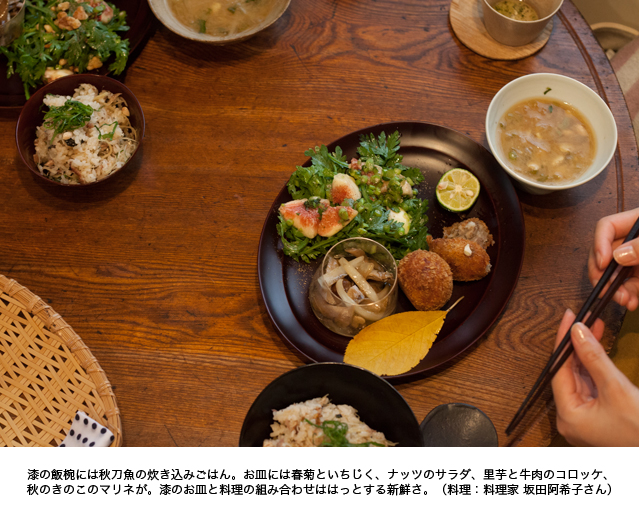
In the lacquered bowl: rice cooked with pieces of Pacific saury. On the plate: salad made with shungiku chrysanthemum leaves, figs, and nuts; taro and beef croquettes; and marinated autumn mushrooms. The combination of the lacquerware plate and the cuisine is strikingly unusual. (Food prepared by culinary expert Sakata Akiko)
Bringing natural irregularity and sleek forms to lacquerware: Kamata Katsuji
After completing high school, Kamata Katsuji decided to attend art school. His ambition was to become a craftsman, since then he would never have to retire. While studying at art school, he became fascinated by the process of making lacquerware and how it didn’t involve dramatically transforming then materials; it was a matter of simply working steadily away. He therefore made up his mind to pursue a career as a lacquer artist. After graduating, he apprenticed under a lacquer artist in Wajima before striking out on his own. He now works in a studio overlooking the ocean off Wajima.
We asked Katsuji about his output.
“People sometimes tend to think that the hallmark of my work is the use of the dry-lacquer technique,” he explained, “but what most interests me is form. I sought to create forms that displayed natural irregularity while still being sleek. I guess the dry-lacquer technique turned out to be the best way to achieve that.”
Lacquerware was not something Katsuji was very familiar with before he started making it himself.
“If I was going to make lacquerware anyway, I wanted it to fit into everyday surroundings. Looking at the dining table of my own home, there are both Japanese and Western elements. I envisioned the kind of dishes that would go well with an everyday table setting. And so inevitably my lacquerware pieces ended up being understated. The colors aren’t flashy, and the surface isn’t smooth and shiny.”
After a piece has been used for a while, the texture of hemp fabric appears on the surface. We asked about that too.
“I wanted to make lacquerware that was as ordinary and down-to-earth as possible, and this was the result. I figured that slightly textured lacquerware would be easier to use than something silky smooth and stiffly formal.”
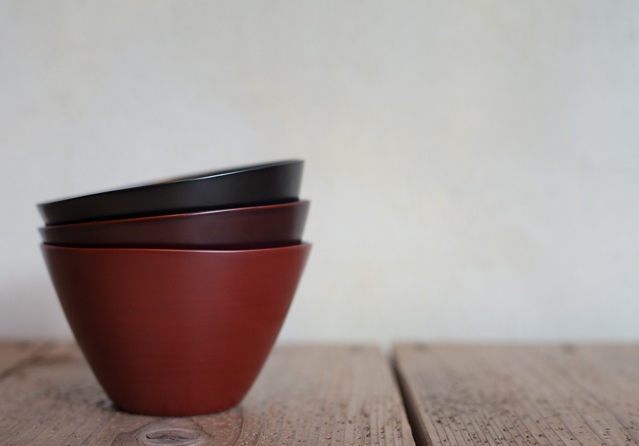
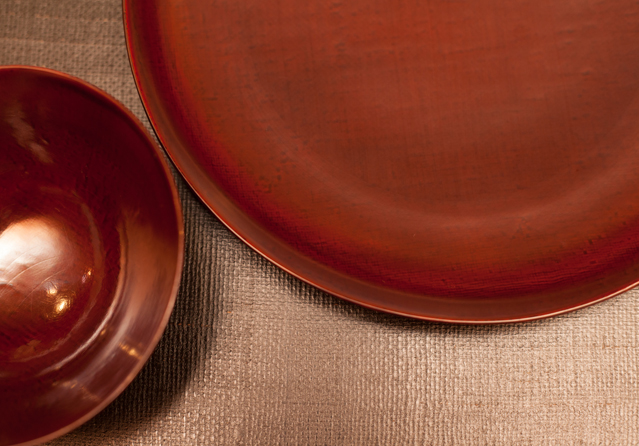
Lacquerware is generally thought of as being fiddly to care for. They say you should avoid putting it in water, but that’s a misunderstanding, according to Katsuji.
“There’s nothing wrong with submerging lacquerware in water as long as it doesn’t have a deep gash reaching the core. On the contrary, after serving rice or something in it, you can soak it in water for ten minutes and give it a gentle wash. That’s better for lacquer than scrubbing it. It’s okay to use dishwashing liquid, but using too much will cause dryness, just as when washing your hands. As long as the dish doesn’t have heavy grease stains, you can rinse it with just cold or hot water and use a sponge. That way it will take on a nice sheen the longer you use it. It’s okay to let lacquerware dry naturally in a dish rack, but wiping it dry with a dishcloth will give it a nice sheen free of water stains.”
One of the great things about lacquerware is that the lacquer can be reapplied.
“A dish that’s become chipped after many years of use can be restored to new by relacquering it. If your lacquerware has scratches that bother you, get it relacquered so you can use it for many more years. It always delights me when I’m reunited with a dish that has been lovingly used for years. I plan to continue making tableware that’s user-friendly for everyone.”

A rice bowl that a customer has asked Kamata Katsuji to relacquer. Katsuji is always delighted to be reunited with a dish that’s been lovingly used like this one.
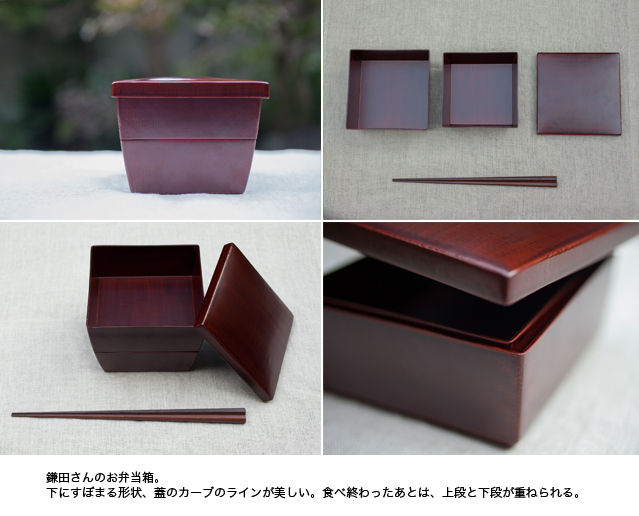
A bento box made by Kamata Katsuji. The tapered design and curved lines of the lid are particularly appealing. The upper and lower sections can be stacked once you finish eating.
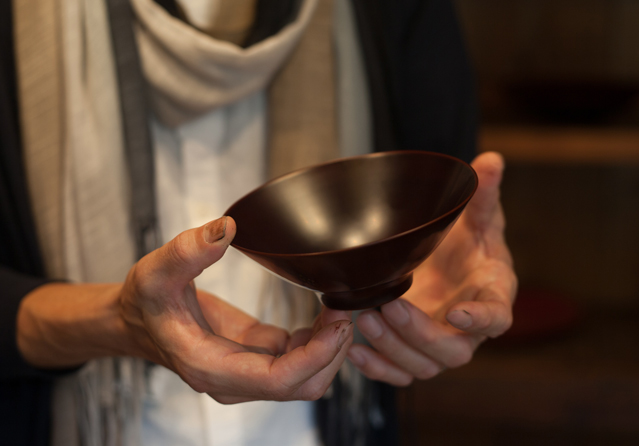
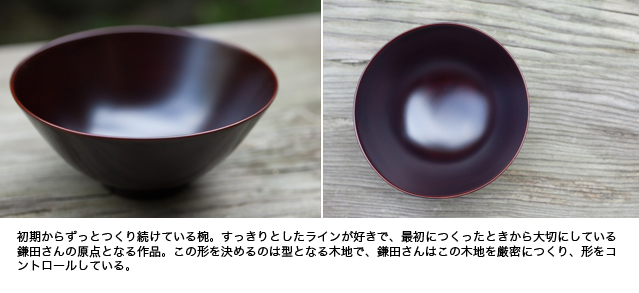
A bowl of a design Katsuji has been making since his earliest days as an artist. This design marks the starting point of his career. He’s fond of its sleek lines, which is why he’s been attached to it since the first time he made it. Its form is determined by the wooden core, which Katsuji makes while carefully controlling its shape.
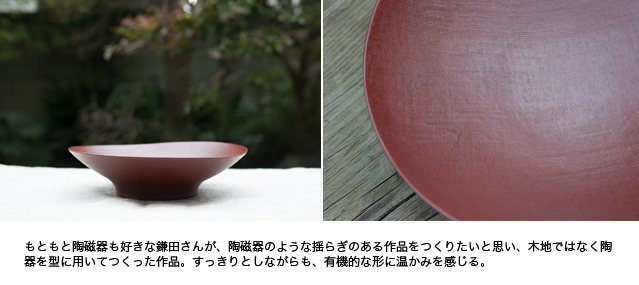
Katsuji has always been fond of pottery. This piece was made with a ceramic rather than a wooden core to create a dish with the subtle irregularity characteristic of that medium. Its sleek yet organic design projects warmth.
